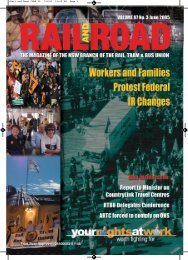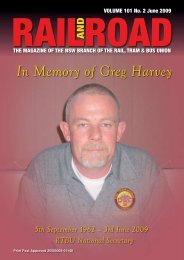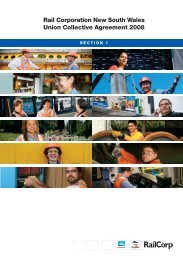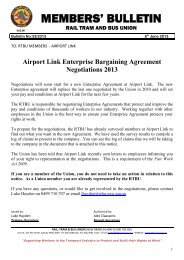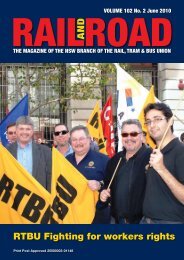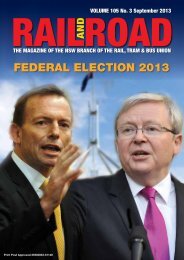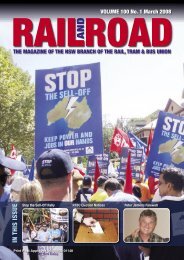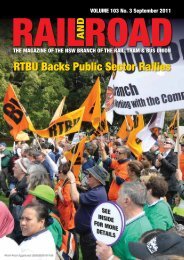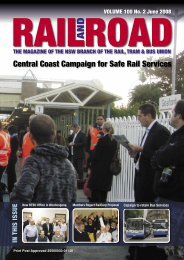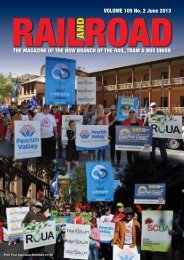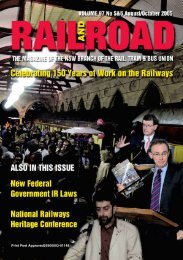Chapter 6: - Rail, Tram and Bus Union of NSW
Chapter 6: - Rail, Tram and Bus Union of NSW
Chapter 6: - Rail, Tram and Bus Union of NSW
You also want an ePaper? Increase the reach of your titles
YUMPU automatically turns print PDFs into web optimized ePapers that Google loves.
*On Wooden <strong>Rail</strong>s <strong>Chapter</strong> 6 8/30/05 8:50 PM Page 207<br />
claims that the number <strong>of</strong> women employed in the<br />
railway is “not particularly significant, with currently<br />
around 11% <strong>of</strong> the workforce as women. The numerical<br />
proportion is not the issue, but how these women work<br />
<strong>and</strong> are treated in the industry, <strong>and</strong> what they can bring<br />
to the workplace is whats important”. 3<br />
Industrial <strong>of</strong>ficers such as Eileen Powell, gained a<br />
reputation as tenacious fighters for union conditions <strong>and</strong><br />
entitlements during the 1930s, as well as a tireless<br />
campaigner <strong>and</strong> activist for pay equity <strong>and</strong> related issues<br />
for women workers. . Her efforts <strong>and</strong> organising skills<br />
during the Refreshment Rooms campaign <strong>and</strong><br />
successful award claim are recounted in this <strong>Chapter</strong>.<br />
Eileen Powell has earned a respected place in the history<br />
<strong>of</strong> the labour movement. She first became involved in<br />
ALP politics by attending branch meetings with her<br />
mother at the age <strong>of</strong> eight. She joined the ALP at the age<br />
<strong>of</strong> fifteen <strong>and</strong> was Assistant Secretary <strong>of</strong> the Stanmore<br />
Branch when she was sixteen. This was the same time<br />
that she started work in Trades Hall performing<br />
secretarial duties. She was employed by the ARU<br />
between 1936 <strong>and</strong> 1944. Apart from building a<br />
reputation as skilled organiser <strong>and</strong> communicator, <strong>and</strong><br />
her work around winning an award for Triple R workers,<br />
she spent much <strong>of</strong> her life campaigning for women<br />
workers.<br />
She was actively engaged in Pay Equity work from the<br />
mid 1930s with the Council for Equal Pay. She gave<br />
evidence in the 1935 Female Wage Case in the Industrial<br />
Commission (at the age <strong>of</strong> 22), appeared with Evatt in<br />
the 1942 Female Wage Case, <strong>and</strong> <strong>of</strong>ficiated on the Labor<br />
Women’s Central Organising Committee. Eileen was<br />
the Australian correspondent for the ILO Committee <strong>of</strong><br />
Experts in the 1940s <strong>and</strong> 1950s, <strong>and</strong> appeared in the<br />
1969 National Wage Case which adopted the principle<br />
<strong>of</strong> equal pay for equal work. 4<br />
These efforts around pay equity, as well as her union <strong>and</strong><br />
Labor party activism were maintained throughout her<br />
life. Her work included, organising both in the ALP <strong>and</strong><br />
the union movement, broadcasting on 2KY<strong>and</strong> public<br />
speaking, writing <strong>and</strong> editing for <strong>Rail</strong>Road <strong>and</strong> the<br />
Labor Council, as well as documenting many <strong>of</strong> these<br />
aspects <strong>of</strong> the labour movement. Eileen was on the<br />
project committee for the ARU <strong>of</strong>ficial history, Working<br />
Lives, written by Mark Hearn in 1990. Eileen Powell<br />
passed away in 1997, <strong>and</strong> in her passing, the labour<br />
movement lost a remarkable <strong>and</strong> dedicated ambassador.<br />
On Wooden <strong>Rail</strong>s - Celebrating 150 Years <strong>of</strong> Work on the <strong>NSW</strong> <strong>Rail</strong>ways<br />
Pat Groves was the first woman to be become a<br />
‘signalman’ on the <strong>NSW</strong> railways in the 1977. Despite<br />
hostility from superiors <strong>and</strong> colleagues, Pat continued to<br />
work in signalling, <strong>and</strong> as a union activist. Pat was<br />
involved in lobbying for a full-time women’s organiser<br />
position in the ARU in the 1980s. Pat was instrumental<br />
in lobbying for the establishment <strong>of</strong> the ARU Women’s<br />
Committee. .In 1981 the Branch Conference had agreed<br />
to establsih a women’s committee, but seemed to take a<br />
back seat to other industrial issues. The Secretary’s<br />
Report to the 1984 Conference, reported that “while in<br />
the process <strong>of</strong> establishing the Committee <strong>and</strong> making it<br />
fully operational, the 1982/83 crisis intervened <strong>and</strong><br />
other campaigns developed…. And the A.R.U.’s total<br />
energies were directed towards the retention <strong>of</strong><br />
jobs…The committee did, however, manage to meet on a<br />
number <strong>of</strong> occasions <strong>and</strong> is beginning to operate on a<br />
strong basis.” 5 . Similarly, the proposal for a woman’s<br />
organiser was defeated by 2 votes at the 1987 State<br />
Conference <strong>of</strong> the ARU.<br />
Pat expressed her concerns <strong>and</strong> disappointment at the<br />
obstacles <strong>and</strong> slow response to changes that would<br />
encourage more women to enter the industry. ‘They are<br />
moving in slowly. We have two signalmen, women<br />
signalmen, a few ASMs, shunters, guards, fettlers, but<br />
never in a mad rush.’ 6<br />
Similar stories can be found in many areas <strong>of</strong> the<br />
industry. Hearn provides the example <strong>of</strong> Mary Stratton,<br />
who joined the industry as a Station assistant at Town<br />
Hall in the 1950s at the age <strong>of</strong> thirty seven. She earned<br />
28 pounds per fortnight for ten hour days with two hour<br />
3 Interview with Linda Carruthers,<br />
4 Rosemary Webb, Commemorating Our Dear departed Equal Pay Activists, Workers Online, Issue 3, March 1999<br />
5 ARU Conference Reports, 1984, p75<br />
6 Pat Groves interview in Hearn, op.cit., p 136<br />
Station Announcer (State <strong>Rail</strong> Archives)<br />
<strong>Chapter</strong> 6 - No Place for a Woman 207





